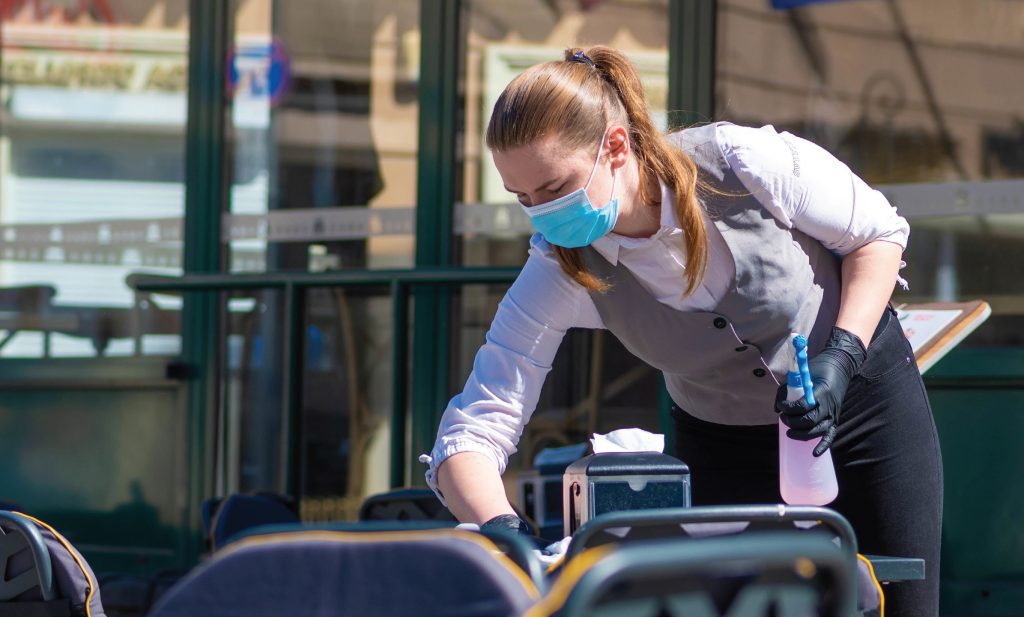Service in a New Era
Posted by estiator at 8 July, at 07 : 30 AM Print
SERVICE 101

By CONSTANTINE KOLITSAS
For decades, the restaurant industry has measured, pondered, studied, and analyzed its service model, continually working to anticipate the needs of guests, and contemplating social trends, customer expectations, and evolving norms. And just when we think we’ve got a good handle on it, along comes a global pandemic. Well, if you’re tired of the phrase “the new normal,” you may want to stop reading now, because the restaurant industry is about to go through a seismic shift as it begins to reopen across the country. And the idea of a “new normal” doesn’t even begin to describe what lies ahead.
For sure the short term will create the greatest challenges. As of this writing, it’s been two weeks since Connecticut began to admit customers for outdoor dining. (I live and work in Connecticut, so it’s my best point of reference.) What we are seeing is minimal traffic in most areas, with the shoreline (always a tourist attraction) and established patio restaurants attracting the most people. For example, a brewery in LitchfieldCounty with a large outdoor beer garden is the big attraction on nice days. They bring in food trucks (lobster being the most popular), and people fill up the location’s socially distanced outdoor tables twice a week. (Under current rules it cannot serve beer unless the guest is also eating.) Other than that, it’s slim pickings.
A luncheonette downtown gets one or two tables most days, while the big Greek diner down the road does only a little better. The high-end restaurants get some traffic, but it’s generally their hard-core customers venturing out to support the eateries that know them by name and drink.
For the most part, customers are hesitant to venture back out into restaurants, despite the rhetoric you come across with the thousands of memes on social media.
This indicates that customers are truly hesitant when it comes to the prolonged contact with outsiders that is characteristic of a restaurant environment. And so, servers need to be aware and be ultra-sensitive in everything they do.
To start with, it goes without saying that servers need to wear gloves and masks, although on a recent visit to a fine-dining Italian restaurant, the server wasn’t wearing gloves and she had her mask strapped to her chin instead of covering her nose and mouth. She seemed to be taking cues from the diners in attendance (three tables’ worth) who were not wearing their masks once they took their seats. The server was wrong, however, and was doing a disservice to her establishment. Guests may feel comfortable without their masks, but they don’t want someone who is out in public all week long breathing on them without protective cover. That they may feel entitled to sit without wearing a mask means nothing. It’s a sad fact, but most people are selfish and don’t care if they give the virus to a server. In a nutshell, here are a few things to put in place to both mitigate the ability for the virus to be transmitted at your business as well as to manage the public’s perception.
● Wait. If you are fortunate enough to have a queue of guests waiting for tables, be sure to have them spaced at six-foot distances, with markers to delineate where they should be positioned while they advance along the queue. Yes, just like Home Depot does.
● Water. Water glasses should be refilled by pitcher that does not leave the server’s possession. In my restaurant, we invested in beautiful water carafes that will sit on the shelves for the next year or so. Before all of this, we would have water glasses as part of the table setting and simply bring out a carafe of water to each table as they were sat. Now you don’t want to have things on the table that will be touched by guests. Bring the water glasses to the guest with water in them when they arrive and just refill from a pitcher.
● Salt, pepper, sugar. Have you ever seen one of those reports on where the most germs exist in restaurants? (Go to YouTube and do a search if you haven’t.) Time and time again the greatest activity is on the salt and pepper shakers that sit on tables. Maybe you were vigilant and had your servers sanitizing them at every table turn. But more than likely, they just sat there waiting to be wiped at the end of the day. In normal times, those items measure high for fecal matter. In these times, just remove them from the table altogether. Get grinders that your servers handle (don’t let customers grind) or just provide single-use packets.
● Menus. In Connecticut they are currently requiring single-use paper menus. Again, menus are right up there with condiments for being key areas of transmission for microbes. The best thing is to put a PDF of your menu online and encourage customers to go to your website to view it.
● Table settings. Table settings sitting on the table in between uses in this environment are not a good idea. Wait until guests are sat to bring them, and when you do, just place a stack of them on the table together for the guests to pass amongst themselves. You don’t want to be hovering over them setting the table while they sit. In our restaurant, we use rolled napkins with silverware inside and share plates. We just count out the plates, stack them together, and put the corresponding number of roll-ups on the top plate. It works.
● Running food. You want to have as few people as possible touching a guest’s plate. The Health Department here recommends having a single server do all of the handling for a table once it leaves the prep line.

● Distance. It’s difficult to take an order from six feet away, but servers should be encouraged to give as much space as needed. They should also not spend extra time talking to guests. Germs spread in the air, even through the masks, so even if you have a table that wants to chat you up, the other tables in the vicinity may get spooked.
● Utensils. Some guest are nervous about using utensils, even though they get washed, rinsed in 180 degree water, and sanitized. Just have some good heavyweight plastic utensils on hand if they request them. And the same for beverage glasses. If they prefer to drink from a plastic single-use cup, then that’s okay. Terrible for the environment, perhaps, but understandable considering the way the virus had been spreading.
● Leftovers. Don’t bring plates of food into the kitchen to scrape into a box. Even before the pandemic, the preference in many markets has been for customers to package their own leftovers. Just have the server bring out the containers and then remove the empty dishes, which should go directly to the dish station.















